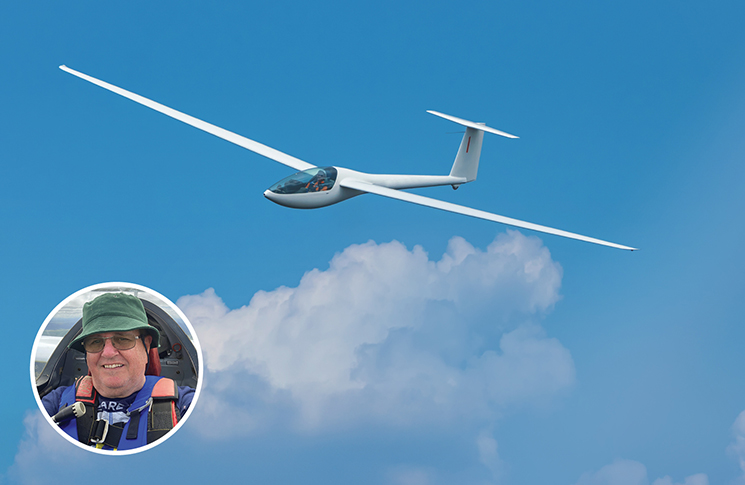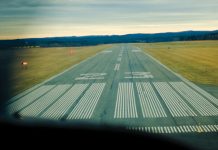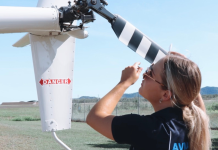Like many soarers, Drew McKinnie started young. He soloed at 15 over Woomera, SA, where his father, a British Royal Air Force avionics technician, was working as a civilian LAME supporting all rocket range aircraft.
‘Out in the desert, your choices were swimming and riding dirt bikes,’ he says, ‘But I thought flying gliders was more exciting.’ The challenges he faces now as safety manager for Gliding Australia are much more varied, yet fundamentally similar to those he mastered as a schoolboy on that hot day many years ago: using systems and rules to develop individual judgement.
Q: Describe your aviation and professional history. Do they interact?
McKinnie: Woomera was a great place to learn and I went solo fairly quickly. When I left school, I joined the Royal Australian Navy and I’ve had a very satisfying career – 37 years full-time as a Weapons Electrical Engineer Officer and then 10 years’ reserve service. I wasn’t a professional aviator in the Navy but I did spend time working on projects involving helicopter integration with ships, helicopter modifications, data links, combat systems, all that sort of stuff. My reserve career was mainly in seaworthiness and airworthiness.
I had to pause my gliding for a while when I was doing my university study. And when I was at sea, I wasn’t able to fly regularly. But, when we visited interesting ports, I often went gliding, in the NT or New Zealand or Hawaii – I would take a launch here and there. And I used to fly a little bit in the summer holidays. I resumed full-time gliding in 1983 and I’m still getting the hang of it now.
Q: So what about your involvement in what’s now known as Gliding Australia?
In the late 80s and early 90s, I was doing a fair bit of instructing and became a level 3 instructor, training the trainer in our system. In 2013, I started as regional manager operations for NSW, looking after the training and audit systems for gliding. Fairly quickly after that, I found myself as the head of the operations department and held that role for 5 years. Then a little pause in my activities until, in 2021, I got the phone call saying, ‘please come and join us as safety manager.’
I was lucky that my predecessor as Gliding Australia safety manager was (Professor) Sidney Dekker. So, I had very big shoes to fill, but also very good mentorship through him. His risk management insights and his drive for simplicity and cultural relevance have been important.
Q: What are the challenges of managing and improving safety in gliding?
We’ve tried to build a safety management system that works for a sport. Gliding is volunteer-based and distributed all over the country – it’s the antithesis of a centrally controlled organisation, like an airline. It’s very dispersed.
That becomes an issue where you need to build trust and have standards managed and enforced by really good role models. You need good training. Instructor training has particular importance in the gliding setting because they become the exemplars of what is taught and enforced throughout the clubs.
Gliding is very much an individual sport in the air and a team sport on the ground. Teamwork builds safety culture.
But that’s also an advantage because clubs can be strong and cohesive. Gliding is a club-based sport and in that respect, it’s got strengths over some general aviation operations where it’s every man for himself, where they might turn up at 2 pm, fly for 2 hours, pay their money and then go home. How do you reach that pilot? However, gliding is very much an individual sport in the air and a team sport on the ground. Teamwork builds safety culture.
Q: How varied is the gliding environment?
It might be an airfield at Cunderin or Narrogin in WA, it might be a paddock near Stonefield in SA or it might be a busy multi-user aerodrome like Temora in NSW. We are training people to operate in all of those environments but I guess one of the most extreme is Southern Cross Gliding Club at Camden, in Class D airspace on the edge of Sydney. They are having to learn in a very busy environment.
Gliding is a sport and lots of people enjoy competition and adventurous flying. So we also have trainers who are high-performance coaches. They are instructors but their area of expertise is on high-speed performance flying or soaring at
high altitude.
Q: What do general aviation and recreational pilots need to know about glider operations?
If there’s a good convergence line of cumulus in the sky, that’s where the gliders are going to be. Or ridges facing wind, or upwind of lenticulars, or under big cumuli. They’re going to follow those lines of energy.
It might be a blue-sky day, in which case they’re wanting to follow thermal sources, follow the ridges, the exposed rock faces facing into the sun. Or the edges of paddocks that line up against a forest. Lines of energy generated from the ground.
Our progress across country is never about cruising at a given flight level. You’re always trading your altitude for distance.
If we’re up high, we’re more likely to be closer to the bases of clouds. If we are down low, we’re going to be closer to those thermal sources on the ground.
Q: How has the technology of gliding progressed and where is it going?
Performance is improving. In 1949 if you flew a glider with a 20:1 glide ratio, that was luxury, that was a hot ship! I fly a ‘vintage’ glider and it’s got a 46:1 glide ratio. There are new gliders achieving 50-55:1 and competition models with glide angles of over 60:1.
We’ve had powered sailplanes for a long time, in 3 main groups. There are touring motor gliders that are like general aviation aircraft but with longer wings. And increasingly we have self-launching gliders and sustainer gliders; the latter can’t self-launch but can turn on an engine to extend flight. Many of these gliders have what we call ‘pop-up toasters’ where the motor and propeller are housed in the fuselage behind the canopy and pop out for use.
These started out as small internal combustion engines. More recently we started seeing sailplanes with retractable turbojet engines in the fuselage – the power to noise ratio is, er, interesting. And the latest developments are battery-electric self-launching or sustainer gliders. Some use a high-efficiency electric motor in the nose cone and a folding propeller for landing or while gliding.
They’re operating at 300 or 400 volts with very sophisticated electronic control systems. And we are working with those manufacturers to have the appropriate training and maintenance systems brought into the country. In that context, I believe CASA is watching with great interest what we do because some of these lessons will translate to other forms of electric-powered aircraft.
It’s a new set of challenges, teaching people, what is maintainable, what’s not maintainable, dealing with high voltages and dealing with the charging systems correctly. It’s important to ensure firmware is configured and upgraded in the correct sequence because you might have several sets of firmware controlling different systems: flight control power management system, battery management system, the engine retractor.
I’m quite certain this experience is going to be beneficial to the lightweight powered aircraft category as they start to transition to electric or hybrid propulsion.
Q: Are there any pilot-related issues that are particularly important in gliding?
Absolutely yes. Currency, recency and proficiency – there’s an interplay between those factors, and total experience. We abide by the same sort of 90-day rules as everyone else in aviation, but we also know how proficiency in making those very fine judgments of safety margins that can be eroded quite quickly.
For example, it includes your ability to perceive changing angles back to a home field or your drift over the ground. If you’re low currency, low recency, your situational awareness is degraded and you may not be proficient in managing those aspects. This is true in all forms of aviation, but in gliding it is particularly important because in most cases, there is no engine to get you home.
In the post-COVID-19 era, where we had a lot of people with very poor currency, we had to tell them to hasten slowly. Take a few launches. Don’t push too hard for the first few, do the local area stuff. Get yourself in the groove before you start flying more demanding flights in blustery weather or turbulence or long-distance cross country.
Our other issue is collision avoidance, and the primary collision risk is glider-to-glider. It’s higher by orders of magnitude than glider to other aircraft. Mixing safely with other aviators is high priority.
Currency, recency and proficiency – there’s an interplay between those factors, and total experience.
And we must not forget ground risks if we’re looking at safety in total: we’ve got tow aircraft, propellers, moving vehicles, winch ropes, high voltage battery systems, slashers and weed killers. All before we get airborne.
Q: What are you doing to address the collision risk?
Lookout is fundamental and that skill is taught from ab initio to competition level. But it is augmented by a system called FLARM – flight alarm. FLARM is a low-cost system using a different frequency to ADS-B (Automatic Dependent Surveillance – Broadcast); it has different collision prediction algorithms that can accommodate climbing, descending and turning aircraft nearby. When you get the FLARM alerts, the audio, flashing red lights and display indications give you the direction that threat is coming from.
The latest versions of FLARM can be linked to conspicuity lights in the nose, that flash when another aircraft is nearby. It’s a good system for gliders and mandatory for competition flying. I would say probably at least three quarters of all gliders in Australia have FLARM fitted now.
We’ve also been encouraging pilots to take up the ADS-B rebate. Most gliders don’t have independent power generation and have limited battery capacity so many pilots have voluntarily taken up using electronic conspicuity equipment. Those transmissions can be seen on ADS-B IN equipped aircraft, and through various receivers on the ground.
In future I hope to see combined ADS-B and FLARM units – these are already available in Europe and the UK where take-up of FLARM is even greater. But their FLARM systems operate at a different frequency to Australia.
We are working hard to get manufacturers to produce units that give both ADS-B and FLARM functionality. It’s going to get pricey, so when we get a viable system approved in Australia, we are going to talk to our friends in the Department of Industry and CASA and see if we can get the ADS-B rebate extended to include those sorts of devices.
Web-based integration of multi-sensor, multi-system situational awareness aids is important to our future. Pilots can now see glider traffic in EFBs and applications like PureTrack.






